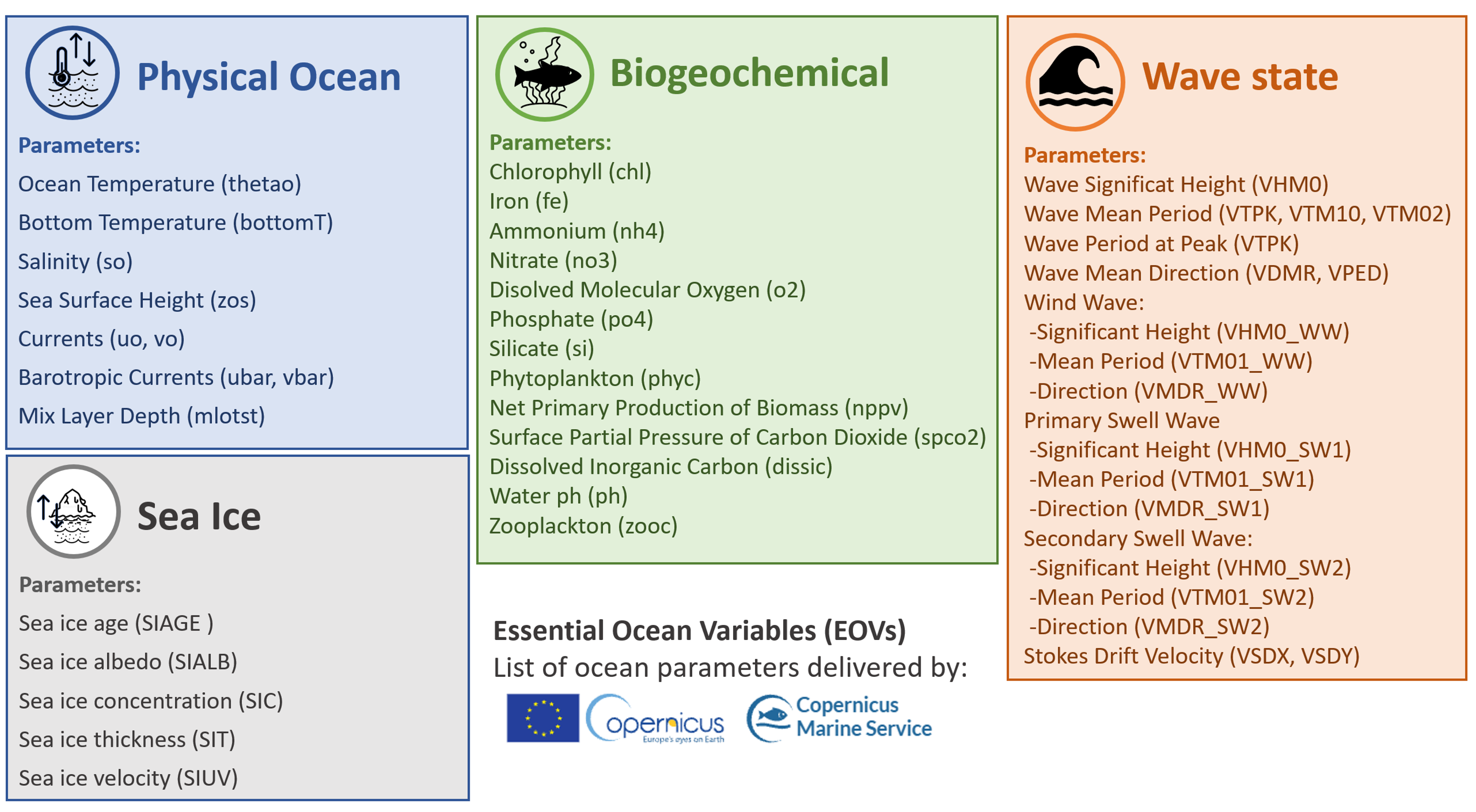Numerical ocean models generate as output a substantial number of variables and volume of data. The variety of variables dealt by such models depends on the type of model applied, the processes included, and the systems involved (for example, ocean models can be coupled to atmospheric and surface wave models, as well as to sea ice models or biogeochemical ones). On the monitoring side, the ability to measure the ocean with new technologies and techniques (related to both remote-sensed and in-situ device observations) has been continuously enhanced since the 1980s as well, resulting in an extended range of ocean variables to deal with.
This wide variety in terms of variables used to monitor and model the ocean is reflected by the CF metadata conventions (🔗1). These conventions are intended to be used with climate and forecast data derived from atmosphere, surface and ocean models, and from comparable observational datasets, and are designed to facilitate the processing and sharing of data files via widely used formats (e.g. NetCDF and ZARR) and web services (e.g. THREDDS and ERDDAP); their use is supported by a wide range of software. The CF Standard Names Table (🔗2) is a living document that is continuously expanded following requests for new variables. In its version 77, dated 19 January 2021, there were 579 standard names that match a query for the strings “seawater” or “ocean”. This number gives an idea of the broad panorama existing in terms of ocean climate and forecast variables.
Due to this great breadth and differentiation of ocean variables, the need arose to agree on some common key variables to monitor the ocean. In the late 1990s, in part motivated by requirements to support activities and negotiations in the framework of the UNFCCC and the IPCC, emerged the concept of ECVs. An ECV is a physical, chemical or biological variable (or a group of linked variables) that critically contributes to the characterization of Earth’s climate. Furthermore, the ECV datasets progressively became also widely used in the context of mitigation and adaptation measures, as well as to assess risks and enable attribution of climate events to underlie causes. This is the fundamental importance of ECVs and the reason for which climate services focus resources to monitor and forecast these minimal sets of “key variables”. Currently, there are 54 identified ECVs (GCOS, 2021). Global expert panels, coordinated by GCOS, are responsible for maintaining updated definitions of the ECVs required to systematically observe the Earth’s changing climate. The ECV specification sheets are intended to be observation platform agnostic, not focusing on what any given existing or novel observational technology can deliver, but on the ultimate resolution and accuracy that the full network of coordinated systems can achieve to meet user requirements.
The WMO defines the following ECVs specifically focused on the ocean (WMO, 2021):
- 12 related to physics: Ocean Surface Heat Flux, Sea Ice (including Concentration, Extent/Edge, Thickness and Drift), Sea Level (Global Mean and Regional), Sea State (Wave Height), Surface Stress, Temperature, Salinity and Currents for both Sea Surface and Subsurface.
- 6 biogeochemical:Inorganic Carbon, Nitrous Oxide (including interior ocean N2O and N2O air-sea flux), Nutrients (including ocean concentrations of silicate, phosphate and nitrate), Ocean Colour (Chlorophyll-a Concentration), Oxygen, and Transient Tracers (CFCs, etc.).
- 2 Biological/Ecosystems: Marine Habitat Properties (Coral Reefs; Mangrove Forests, Seagrass Beds, Macroalgal Communities) and Plankton (Phytoplankton and Zooplankton).

Ocean monitoring and forecasting services focus their resources on covering most of these ocean ECVs. Actually, there is an expanded list of EOVs maintained by the GOOS (Sloyan et al., 2019) in collaboration with panels provided by the OOPC panel and the IOCCP. GOOS aims to periodically re-evaluate and update the EOVs list. Importantly, the EOVs include observable ecosystem and biogeochemical characteristics of the ocean that are needed for understanding the state and health of the marine environment, currently under pressure by human stressors and climate change. While networks that observe the physical ECVs/EOVs are generally well established, those working on biogeochemical and ecosystem EOVs are in most cases still in the concept or pilot phase. Nevertheless, acquisition of these data by regional and global observing systems is essential to the development of model-based forecasting capabilities. For further details on the on-going actions and the path forward to extend operational monitoring of these ocean variables see Muller-Karger et al. (2018).
Some marine services already go beyond the Ocean-ECV and EOV lists, delivering model and observation products for a broader set of variables. This is the case for the Copernicus Marine Service, which monitors Ocean-ECVs (as described in its “Ocean State Report (OSR)”, Copernicus Marine Service, 2021b), but goes even further than the common list delivering more variables and indicators of interest for a wide-ranging end user community through its Product Portfolio (Copernicus Marine Service, 2021c). A summary of EOVs and parameters delivered by the Copernicus Marine Service is shown in Figure 3.1. Copernicus Marine Service is a good example of what occurs across most of the trans-national, national or regional ocean monitoring and forecasting services.


Follow us